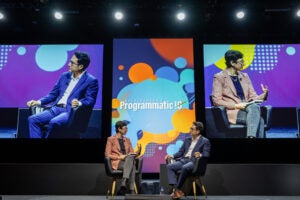 The Economist has rolled out “First Impression” multiplatform ad units to let advertisers grab a weekly premium spot across all Economist channels, including its website, tablet and smartphone apps, as well as its print edition.
The Economist has rolled out “First Impression” multiplatform ad units to let advertisers grab a weekly premium spot across all Economist channels, including its website, tablet and smartphone apps, as well as its print edition.
The publisher has also debuted a new weekly reader measurement called “Total Economist Weekly Audience” (TEWA) in partnership with PricewaterhouseCoopers to help advertisers determine how people are accessing its content. One TEWA finding indicates close to 40% of The Economist’s readers consume their content on at least two platforms.
David Kaye, The Economist’s senior vice president and chief revenue officer, spoke with AdExchanger about the new initiatives.
AdExchanger: Can you describe The Economist’s audience reach?
DAVID KAYE: The global audience is a little more than 1.4 million for print and about 170,000 for digital-only. If you’d like both, you actually have to pay a little more.
How are readers consuming content cross-platform?
When we found out that almost 40% of The Economist’s worldwide readership consumes the content across at least two platforms, we weren’t terribly surprised. We always knew our audience used multiple platforms. Economist readers are certainly comfortable with technology, and they are frequent travelers equipped with an array of devices.
Why is the First Impression program unique?
We tell advertisers that if you believe in the Economist audience, you might like to get your message in front of them everywhere they are and can we create a premium package that gives you first access to each individual. It includes the back cover of the magazine and the cover positions in our tablet and mobile apps. We also make sure we serve the ad as the first impression on the website no matter where a visitor comes from. For one full week, the advertiser has first shot at all the eyeballs, and we think that’s pretty cool. Samsung is our first customer.
Will First Impression be sold on a weekly basis?
We can’t sell every week because it’s tough to coordinate, (since) a lot of that premium inventory has already been pre-sold for the year. What we can sell on a more consistent basis is the total Economist audience. We understand our duplication numbers, so we can take a premium spot in print and find a comparable spot on the apps and the website and put a guaranteed number of impressions around them.
Can you share what The Economist is doing with programmatic sales?
We have DFP (DoubleClick for Publishers) set up, and we work with Google, so there are some opportunities to buy The Economist programmatically but we don’t put inventory out on open exchanges. If you want to work with us programmatically, you have to come to us. We’re more interested in premium programmatic direct. We don’t have the scale that some of the larger content providers have, and we come close to selling out our inventory quite often anyway. The world is certainly moving toward programmatic, and we want to have options, but we’ll use it as something additive to bigger programs we’re building. Of course we want to make it easy for clients to buy, so we know we have to be there in some form.
Do you see demand from agencies to automate the traditional ad sales process?
It’s happening, but it depends on which part of the agency you’re working with. There are some parts that don’t get involved in programmatic, so sometimes you have to seek out the trading desk partner. We work with many agencies who say, “Yeah, we’ll do it someday, but most of our deals are still done directly.” Despite the efficiency and the automation, there are still a lot of people who aren’t pushing hard for it yet.











